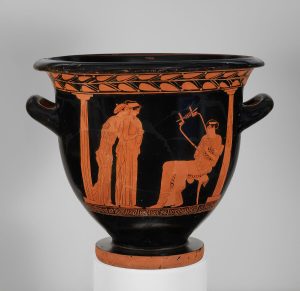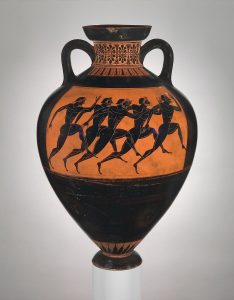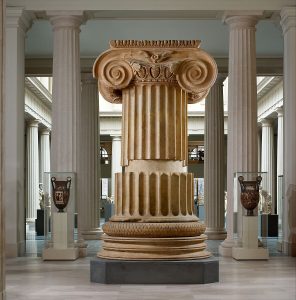4 Chapter 4: The art of classical antiquity, in the ancient Mediterranean
Maria Americo
Chapter 4: The Art of Classical Antiquity, in the Ancient Mediterranean
Welcome to our second chapter of looking at art together. In this chapter, we explore art from classical antiquity (from approximately 800 BCE-300 CE) in the ancient Mediterranean region, a time and place that were extremely formative for the later history of Europe, the Middle East, North Africa, Central Asia, and beyond!
Terracotta bell-krater (bowl for mixing wine and water)
Greek
c. 460 BCE
-Image by the Metropolitan Museum of Art, used under a Creative Commons Zero (CC0) license, Public Domain
-Learn more about the art and find the image source here.
Welcome to our first “Greek vase” of this textbook! The painted Greek vase is one of the most famous and most recognizable of the styles of ancient art. This example is what’s known as a red-figure vase, and this style of vase art is made when the background of the clay is painted black, while the figures and images are created by leaving the original red or orange surface color of the clay unpainted. This vase shape is called a bell krater, and its purpose was for mixing wine and water—perhaps at a symposium, a gathering where the (male) revelers would gather, drink wine mixed with water, discuss topics of philosophy (as they grew increasingly drunk), and experience entertainments like music or dance performances. The most famous literary description of a symposium was that by Plato, the ancient Greek philosopher.
This vase does not depict a symposium, at least not one of the kind described by Plato. It shows two women in an intimate pose, embracing in each other’s arms while a third woman plays the lyre and sings for them. Scholars sometimes identify the woman playing the lyre and singing as Sappho, the well-known Lesbian (and lesbian) poet. Often our understanding of antiquity was that women could not read and write or participate in the world of art and literature, that women’s daily lives existed to serve and support the men in their lives, and that ancient art was not for the female gaze or representative of women’s lived experiences. Artworks like this piece, which show only women in intimate spaces together, creating and enjoying art, help to challenge that stereotype.
Questions for reflection
- Describe the scene on this art piece. What do you see here?
- Describe the figures’ clothing, accessories, objects, physical setting, and the frame of the vase that surrounds them.
- Read a little of Plato’s Symposium, or a poem or two by Sappho. Find something in one or both of these texts that relates to or reminds you of this vase.
- What do you think the woman is singing about in the scene on this vase?
- If you attended a party where you had to make a speech about a philosophical topic in front of your friends, what would you speak on?
Sources and further reading for this art
Sappho – Poems by the Famous Poet – All Poetry
Terracotta Panathenaic prize amphora
Greek
c. 530 BCE
-Image by the Metropolitan Museum of Art, used under a Creative Commons Zero (CC0) license, Public Domain
-Learn more about this art and find the image source here.
This ancient Greek vase was given to the winner of an athletic contest at a sports competition—the footrace. In ancient Greek athletic contests, like the famous ancient Olympics, champions would often win a vase that depicted the sport in which they had won. So although we do not know the name of the person who won this vase, we can assume that they competed in and won the footrace. As this vase depicts, there is evidence that ancient Greek athletes did indeed compete in races, and other athletic events, barefoot and naked. For a sort of bonus prize, the vase might also have been filled with a valuable liquid, like wine or olive oil.
This is a black-figure vase, in which the figures were painted in black paint against the red or orange surface color of the clay. This is one of the most famous examples of the black-figure vase, in which the musculature, mental focus and purpose, and shape and composition of the runners’ bodies still come through easily for the viewer, thousands of years after this artwork’s creation.
Questions for reflection
- What do you notice about the way the athletes are depicted on this vase?
- How do the shape and arrangement of the runners on this vase complement and conform to the shape of the vessel overall?
- Imagine the daily life of the runner who won this vase, or write a story about a day in their life.
Source and further reading on this art
The Ancient Olympics and Other Athletic Games – The Metropolitan Museum of Art
3. 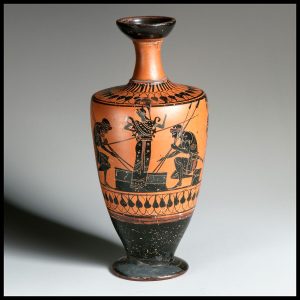
Terracotta lekythos (oil flask)
Greek
Late 6th century BCE
-Image by the Metropolitan Museum of Art, used under a Creative Commons Zero (CC0) license, Public Domain
-Learn more about this art and find the image source here.
This black-figure vase depicts one of the most famous scenes of ancient Mediterranean vase painting: Achilles and Ajax, two great warriors of the Trojan War, playing a board game during the “break” that the two opposing armies of the Trojan War took, when the fighting came to a standstill. Though the two are not actively engaged in fighting during this part of the story, the viewer is made to understand that they are keeping their combat skills fresh, and that they would be ready to return to the fighting at a moment’s notice if called: their weapons are nearby, and they are playing a game of strategy. (Many board games, even in the modern day, have a military or strategic theme, from chess to Battleship.) Standing between them is Athena, the goddess of war, wisdom, and battle strategy, adding to this thematic idea.
One of the things this vase helps us remember is that ancient art had the power to tell a story. You may know that the story of the warriors Achilles and Ajax (depicted here), and all the other warriors of the Trojan War, was created in written form by Homer, in his epic poem The Iliad. When we experience The Iliad today, it is likely that we encounter it in its written form; that we read it. But in the ancient world, a world with far lower levels of overall literacy than we have today, there would have been other ways of experiencing this famous and culturally foundational story. All ancient poetry, from the long epics of Homer to the short lyrics of Sappho, would have been sung out loud rather than read, and accompanied by live music. (All music in ancient times was, of course, experienced live, as recording technology had not been invented yet, and would not be invented for thousands of years.) So some audiences would have experienced ancient myths and stories aurally, in the form of live music and poetry performances. And some would have experienced it visually, like the many viewers of this vase who have seen it in the millennia since it was painted. Art tells a story. And the viewer does not need to be literate in order to “read” it.
Questions for reflection
- Write the story of the scene depicted in this vase. Include some dialog. What are the characters saying to one another during this scene?
- Notice the objects, setting, and mode of dress of the figures in this scene.
- Why is the goddess Athena here? Does she have a message for the warriors?
- Describe the shape and frame/border of this vase.
Source and further reading for this art
4. 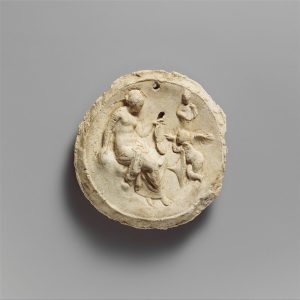
Emblema with Aphrodite and Eros
Mediterranean
1st–2nd century CE
-Image by the Metropolitan Museum of Art, used under a Creative Commons Zero (CC0) license, Public Domain
-Learn more about this art and find the image source here.
This plaster emblema (an ornament for decorating a wall) has a provenance that is different from its place of creation. Provenance is a historical term that means “archaeological find spot”—where a premodern object was discovered, archaeologically. This piece of art was created in one place (somewhere in the Mediterranean) but found by archaeologists somewhere else. This means that, at some point during the life of this art, it moved borders. Someone traveled to the Mediterranean and brought it home as a souvenir. A merchant brought it over on a trading ship, hoping to find a new market for Mediterranean art with themes of Greek mythology.
You may notice that the aesthetic, vibe, and mythological imagery of this art piece are all Greek, or Mediterranean. It depicts Aphrodite, the goddess of love and sexuality, and Eros, the winged cupid figure, the god of erotic love and sex. But this object was found at an archaeological site in Begram, in northeastern Afghanistan, thousands of miles from the creation place of this piece of art. Historically, one of the events that led to trade routes opening between the Mediterranean and the Middle East were the conquests of Alexander the Great, who led his armies from Greece to India, leading to a historical period that we call Hellenistic, or “Greek-ish.”
The story of this artwork reminds us of the great extent of trade, commerce, and travel in ancient times. We are not the first globalized society; there is evidence for trade, travel, and even for people choosing to leave their homelands and settle in places thousands of miles away, from the earliest eras of human history. This piece also reminds us of the power of art, idea, story, and mythology to cross borders. The style of this art, or perhaps its mythology, appealed to someone from a very different culture than the person who created it. Art is a universal language, and its inspiration belongs to us all.
Questions for reflection
- Do you know any myths of Aphrodite, Eros, or any other deity of love? If not, make one up! Myth exists because people made it up. Anyone can do it.
- What about this piece of art do you think appealed to people of different cultures? Is anything about it “universal”?
- What physical detail about this artwork helps us identify it as an ornament to be hung on a wall?
- How are Aphrodite and Eros relating to and interacting with one another in this art piece? What is their body language? Imagine what they are saying to one another.
Source and further reading for this art
Art of the Hellenistic Age and the Hellenistic Tradition – The Metropolitan Museum of Art
Marble column from the Temple of Artemis at Sardis
Greek
300 BCE
-Image by the Metropolitan Museum of Art, used under a Creative Commons Zero (CC0) license, Public Domain
-Learn more about this artwork and find the image source here.
This is a marble column that originally helped provide the architectural support for an ancient temple, to the goddess Artemis, in the city of Sardis, which is located in modern-day Turkey. Parts of the shaft and the base of this column have been restored (meaning that they do not survive in their original form), and the 58-foot-high column now lives in a gallery at the Metropolitan Museum of Art, in New York City. This artwork, like all of the art we have explored in this book up until now, is very far from its original home.
Unlike the houses of worship of many other religions, ancient Greek temples were not meeting places for the community, and community worship of deities did not take place inside them. Ancient Greek temples were meant to house the holy statues and images of the gods, and only priests and priestesses were allowed to enter them. Community worship, ritual, and other religious activities took place outside of the temples, in the holy precincts that surrounded the temples.
Artemis was the goddess of the hunt, the wilderness, animals, and nature. She was also, although she herself was an unmarried and solitary goddess who belonged only to herself and roamed the wilderness, the patron goddess and protectress of pregnant people, childbirth, and children. She was worshipped via festivals, ritual, and sacrifices all over the Mediterranean world. For one famous example, young teenage girls around Athens were sent to live at a temple to Artemis in the city of Brauron for a period of one year, to serve the goddess, and as a coming-of-age ritual.
Questions for reflection
Describe the artistic, stylistic, and architectural details of this marble column in close detail.
- Imagine what went on in the sacred precinct around the temple of Artemis outside of the temple where this column used to stand.
- As we’ve learned, this column used to belong to a holy site, so sacred that “regular folks” could not even enter it. Should religious objects like this one be kept in museums? Is it disrespectful to house holy objects in museums, far from home?
- Do ancient objects “lose” their holiness over time? If no one still worships an ancient god or goddess, are the objects that were once sacred to them still considered holy?
Sources and further reading for this art
Greek Gods and Religious Practices – The Metropolitan Museum of Art
Media Attributions
- terracotta bell krater sappho
- Terracotta Panathenaic prize amphora
- Terracotta lekythos (oil flask) achilles
- Emblema with Aphrodite and Eros
- Marble column from the Temple of Artemis at Sardis
